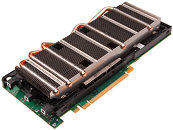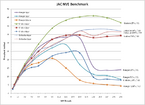Tuesday, May 17th 2011

New NVIDIA Tesla GPU Smashes World Record in Scientific Computation
NVIDIA today unveiled the Tesla M2090 GPU, the world's fastest parallel processor for high performance computing. In addition, the Tesla M2090 GPU achieved the fastest-ever performance in a key measure of scientific computation. Equipped with 512 CUDA parallel processing cores, the Tesla M2090 GPU delivers 665 gigaflops of peak double-precision performance, enabling application acceleration by up to 10x compared to using a CPU alone.
In the latest version of AMBER 11, one of the most widely used applications for simulating behaviors of biomolecules, four Tesla M2090 GPUs coupled with four CPUs delivered record performance of 69 nanoseconds of simulation per day. The fastest AMBER performance recorded on a CPU-only supercomputer is 46 ns/day."This is the fastest result ever reported. With Tesla M2090 GPUs, AMBER users in university departments can obtain application performance that outstrips what is possible even with extensive supercomputer access," said Ross Walker, assistant research professor at the San Diego Computer Center, and principle contributor to the AMBER code.
The Tesla M2090 GPU will be available in servers such as the new HP ProLiant SL390 G7 4U server. As part of the SL6500 Scalable System of HP server solutions, optimized for scale-out and HPC market segments, the SL390 family was purpose built for hybrid computing environments that combine GPUs and CPUs.
The SL390 G7 4U server incorporates up to eight Tesla M2090 GPUs in a half-width 4U chassis and, with a configuration of eight GPUs to two CPUs, offers the highest GPU-to-CPU density on the market. The system is ideally suited for applications ranging from quantum chemistry and molecular dynamics to seismic processing and data analytics.
"Clients running intensive data center applications require systems that can process massive amounts of complex data quickly and efficiently," said Glenn Keels, director of marketing, Hyperscale business unit, HP. "The decade long collaboration between HP and NVIDIA has created one of the industry's fastest CPU to GPU configurations available, delivering clients the needed processing power and speed to handle the most complex scientific computations."
In addition to AMBER, the Tesla M2090 GPU is ideally suited to a wide range of GPU-accelerated HPC applications. These include molecular dynamics applications, NAMD and GROMACS, computer-aided engineering applications, ANSYS Mechanical, Altair Acusolve and Simulia Abaqus, earth science applications, WRF, HOMME and ASUCA, oil and gas applications, Paradigm Voxelgeo and Schlumberger Petrel as well as other key applications such as MATLAB, GADGET2 and GPU-BLAST.
For more information on the HP ProLiant SL390 G7 4U server, go here, and for more information on the Tesla M2090 and the whole family of M-class products, please go here.
In the latest version of AMBER 11, one of the most widely used applications for simulating behaviors of biomolecules, four Tesla M2090 GPUs coupled with four CPUs delivered record performance of 69 nanoseconds of simulation per day. The fastest AMBER performance recorded on a CPU-only supercomputer is 46 ns/day."This is the fastest result ever reported. With Tesla M2090 GPUs, AMBER users in university departments can obtain application performance that outstrips what is possible even with extensive supercomputer access," said Ross Walker, assistant research professor at the San Diego Computer Center, and principle contributor to the AMBER code.
The Tesla M2090 GPU will be available in servers such as the new HP ProLiant SL390 G7 4U server. As part of the SL6500 Scalable System of HP server solutions, optimized for scale-out and HPC market segments, the SL390 family was purpose built for hybrid computing environments that combine GPUs and CPUs.
The SL390 G7 4U server incorporates up to eight Tesla M2090 GPUs in a half-width 4U chassis and, with a configuration of eight GPUs to two CPUs, offers the highest GPU-to-CPU density on the market. The system is ideally suited for applications ranging from quantum chemistry and molecular dynamics to seismic processing and data analytics.
"Clients running intensive data center applications require systems that can process massive amounts of complex data quickly and efficiently," said Glenn Keels, director of marketing, Hyperscale business unit, HP. "The decade long collaboration between HP and NVIDIA has created one of the industry's fastest CPU to GPU configurations available, delivering clients the needed processing power and speed to handle the most complex scientific computations."
In addition to AMBER, the Tesla M2090 GPU is ideally suited to a wide range of GPU-accelerated HPC applications. These include molecular dynamics applications, NAMD and GROMACS, computer-aided engineering applications, ANSYS Mechanical, Altair Acusolve and Simulia Abaqus, earth science applications, WRF, HOMME and ASUCA, oil and gas applications, Paradigm Voxelgeo and Schlumberger Petrel as well as other key applications such as MATLAB, GADGET2 and GPU-BLAST.
For more information on the HP ProLiant SL390 G7 4U server, go here, and for more information on the Tesla M2090 and the whole family of M-class products, please go here.


25 Comments on New NVIDIA Tesla GPU Smashes World Record in Scientific Computation
Edit, Nevermind... "nanoseconds of simulation per day"
I could have told them that.
The suite of AMBER program calculates molecular force fields and molecular trajectories of interacting molecules within a given fixed field.
The amount of data calculation to see what happens in a fixed multi-molecular field in 1 nanosecond is astronomical. The computations for single molecule interaction in staggering.
Doing 69ns in a 24 hour period is a real achievement, and I applaude Nvidia on their continued advancement into supercomputing.
Don't expect to see this in Duke Nukem Forever.
Edit: I found this. Looks like it is indeed a GF 110 core. I wonder if someone could take a GTX 580 and manipulate it into one of these new Tesla cards.
www.nvidia.com/docs/IO/105880/DS_Tesla-M2090_LR.pdf
But as this has four Tesla M2090 GPU's coupled with four CPU's and pumped out 69 nanoseconds of simulation in 24 hours, assuming perfect scaling how many would be needed to simulate in real time? :laugh: it's 6am so I'm not doing the math.
(that's 1.25 trillion systems like the one in question)
My logical GPGPU solution would be get the gtx 590 and 12GB kit. You can share system's memory anyway.
Yes i know it does not really work like that and the max transistor speed does not mean how fast the transistors can work in a chip but my point is there is a bunch of new tech that could replace current form silicone chips that could give one hell of a speed boost, personally i can't wait for us to hit the wall down around 8 or 10nm or whatever it will be.